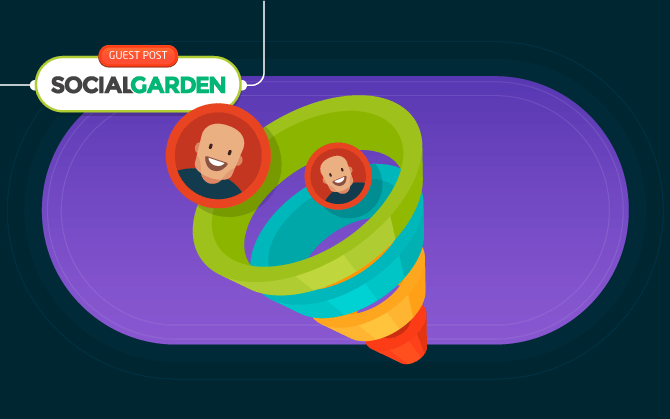
5 Major Things to Think About When Charting a Customer Journey
Step-by-step guidance on how to create a customer journey map.

What will we see in this post
Does your company have a solid customer journey marketing strategy? When done well, customer journey marketing can boost the success of your business.
In this article, we’ll talk about the benefits of customer journey mapping. We’ll also show you how to create a customer journey map in 5 actionable steps.
What is customer journey marketing?
The customer journey
To understand customer journey marketing, first you need to understand the customer journey.
When a customer interacts with your business, usually they have a goal. Their goal might be to make a purchase, find information, engage with a community or many other possibilities.
Customers also interact with your business in a number of ways. This might be online, over the phone or in person. It might be via your website, social media or another third party platform. When a customer interacts with your business in a number of ways, we call this multi-channel engagement.
Therefore, the customer journey is the steps that your customer takes to achieve their goal, usually to make a purchase.
Customers might interact with your business several times in several different ways before making a purchase. That means the customer journey is not necessarily linear. It could involve going back and forth or going in circles. These days, it’s usually multi-channel.
For example, a customer might go to your website, put items in their cart, abandon their cart, browse your IG posts, then return to your website to complete a purchase.
Customer journey mapping
Customer journey mapping helps you understand the process your customer goes through to achieve their goal. It involves creating a visual representation of the customer’s journey.
Customer journey mapping helps you learn more about your customers motivations, needs and desires.
You also learn about the difficulties they go through when trying to achieve their goals. These are sometimes called pain points or obstacles to purchase.
In your map, you will include all stages of the journey from discovery of your business to repeat purchases.
The benefits of customer journey mapping
Boost ROI
The goal of customer journey marketing is to make the buyer’s journey smoother for your customers. In doing this, you might minimise the steps it takes for them to complete a purchase.
On the other hand, some customers need several steps in the buyer’s journey in a non-linear process. If you try to rush them along or skip a step, you lose them altogether.
But regardless of what your customer journey looks like, the idea is that you help them along the path that allows them to achieve their goal. Once you do this, you increase your sales and boost your ROI.
Understand customers better
Sure, collecting demographic information about your customers is important. It helps you understand what they want, how much they can spend, and what prevents them from making a purchase. You can know all of their demographics and still not fully understand how they make a purchase from your business.
But it isn’t until you start mapping out your customer’s journey that you deepen your understanding of your customers. Through customer journey mapping, you’ll learn surprising new things about your customer’s motivations and behaviours.
In the digital age, your customers’ needs and behaviours are always evolving. This makes it even more important to do continuous customer journey marketing to keep up-to-date.
Do more inbound, less outbound marketing
Outbound marketing is the inefficient process of interrupting customers in their daily lives and trying to persuade them to buy your product.
A much more efficient type of marketing is inbound marketing, where customers come to you.
However, inbound marketing does not mean you sit back and put your feet up. You need to create content that will attract leads and nurture them to purchase.
Customer journey mapping helps you do more inbound marketing, as you gain a better understanding of your customers’ needs, motivations and pain points.
Be more customer-focused
Customer service and support teams are already very customer-focused. But this isn’t always the case for some other arms of your business.
By sharing a customer journey map with your entire organisation, you get so many benefits. You can help other departments be more customer-focused. Not just that, you can also improve cohesion within the company, as the left arm knows what the right arm is doing. Taking on a more customer-focused approach will not go unnoticed!
How to create a customer journey map
1. Dat
To discover your customer journey, you’ll need to get data on everything from your customer’s demographics to their online behaviours.
Because a customer journey is often multi-channel, use a tool such as Salesforce that can integrate data from multiple platforms and sources. Read more about it in Connecting Your Customer Journey: Salesforce CRM & Paid Media.
2. Feedback
One of the best ways to get more data is by speaking directly with your customers. You can do research and get customer feedback through forms and questionnaires.
Make sure you speak to actual customers and not prospective customers. You want to speak to people who’ve spent time on your website, who engage with your social media channels, who make purchases online or who come into your physical store.
3. Personas
Now that you have data on your customers online behaviours and feedback from them directly, you’re ready to create customer personas.
Customer personas are incredibly helpful because they help you to understand your customers better, and therefore help you to create better solutions. Personas are also essential to customer journey mapping.
You will have several personas that embody different customer groupings or “segments.” Keep in mind that these audiences might have different customer journeys.
There are plenty of tools available online to help you create customer personas. We really like HubSpot’s Make My Persona Tool, which lets you humanise an audience segment through visual representation.
Create your first map by choosing your most typical customer persona, i.e. the persona that embodies your largest grouping of customers.
4. Touchpoints
Your research should reveal all the ways that your customer will interact with you, in other words, all of your customer “touchpoints.” Your research might also reveal touchpoints that don’t yet exist but probably should.
Create a master list of all of your touchpoints. Touchpoints can include:
- Your company website
- Social media channels (Facebook, Instagram, LinkedIn, Twitter, SnapChat, TikTok, Pinterest, Youtube, Tumblr, WeChat)
- Third party sites like Amazon, Ebay
- Paid advertising (including Google and social media)
- Messaging apps (Messenger, WhatsApp, WeChat)
- Online forums (Reddit, Quora, Yelp, Goodreads)
- Physical store
- Telephone
For example, some customer feedback might be that they want to access your company through a particular social media channel. Alternatively, you might discover an audience demographic that you didn’t know you had, and therefore you’ll want to create new channels with which to engage them better.
By understanding your customer touchpoints, you’ll discover what actions they are performing. It will also shed light on your current customer journey and how it can be improved.
Your customers might have more touchpoints that you expected, revealing a glitch in your website design that makes checkout difficult. Or you might discover there are less touchpoints than expected, which could reveal a significant number of customers “dropping off” the buyer’s journey before they make a purchase.
5. Mapping
Because the customer journey can be multi-channel and non-linear, it can also be hard to map. Creating the map will be a long process that takes time and energy.
There are endless ways that you can create a customer journey map. Here are just some ideas:
- Post it notes on a board
- Spreadsheets
- Infographics
- Digital tools
The main thing is that it is thorough, accurate and makes sense to your team.
You can also find some great examples online, such as Hubspot’s excellent Customer Journey Map Templates.
In your customer journey map, include:
- Touchpoints
- Key events
- Customer motivations
- Pain points
- Obstacles
Start with your first touchpoint and plot the persona’s behavior until they reach their goal.
Ask yourself, did they reach their goal? If so, how can we help them reach their goal in a faster or smoother way? And how can we keep them with us (nurture them) so that they buy again?
Perfect your customer journey marketing
In this article, we’ve shown you the amazing benefits of customer journey mapping, from deepening your understanding of your customers to boosting your company’s ROI.
We’ve also given you an in-depth account of how to create a customer journey map using a step-by-step process. Your steps should start with research and data, and culminate in visual representations of your customer’s journey.
Now that you’ve got a handle on the basics, it’s time to give it a try.
Be aware that customer journey marketing is an ongoing process. As time goes on, your customers may change their online purchasing habits, or a new competitor could alter the way customers interact with your brand.
Keep your customer journey map up-to-date by revisiting it regularly and seeking regular feedback from your customers.
BY GEORGE GLOVER George is the CEO and Co-Founder of digital marketing agency Social Garden. Social Garden specialises in data-driven lead generation and marketing automation to grow companies’ revenue in different verticals in Australia.





